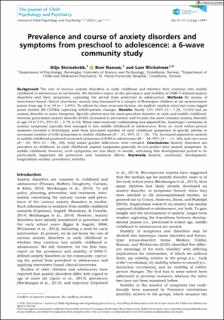| dc.description.abstract | Background: The rate of various anxiety disorders in early childhood and whether they continue into middle childhood or adolescence is not known. We therefore report on the prevalence and stability of DSM-5-defined anxiety disorders and their symptoms, capturing the period from preschool to adolescence. Methods: By means of interviewer-based clinical interviews, anxiety was measured in a sample of Norwegian children at six measurement points from age 4 to 14 (n = 1,041). To adjust for time-invariant factors, we applied random intercept cross-lagged panel models (RI-CLPMs) capturing within-person changes. Results: Nearly 10% (95% CI = 7.29, 12.63) had an anxiety disorder at some timepoint. Specific phobia was the most prevalent disorder in early and middle childhood, whereas generalized anxiety disorder (GAD) increased in prevalence and became the most common anxiety disorder at age 14 (4.51%, 95% CI = 2.78, 6.23). When time-invariant confounding was adjusted for, homotypic continuity in anxiety symptoms typically first emerged in late middle childhood or adolescence. Even so, such within-person analyses revealed a heterotypic path from increased number of early childhood symptoms of specific phobia to increased number of GAD symptoms in middle childhood (B = .41, 95% CI = .06, .75). Increased separation anxiety in middle childhood predicted increased symptoms of GAD in adolescence (B = .38, 95% CI = .14, .62), and vice versa(B = .05, 95% CI = .00, .09). Only minor gender differences were revealed. Conclusions: Anxiety disorders are prevalent in childhood. In early childhood, anxiety symptoms generally do not predict later anxiety symptoms. In middle childhood, however, such symptoms are less likely to vanish, indicating this developmental period to be particularly important for preventive and treatment efforts. | en_US |

